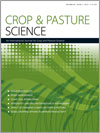During the 2007 winter cropping season in Australia, severe leaf-spotting (necrosis) symptoms resembling chloride (Cl–) deficiency found in North America were reported in the newly released durum wheat variety Jandaroi. Testing for bacterial, fungal and viral pathogens all proved negative. Four Australian durum and four Australian bread wheat varieties were grown, along with a North American variety of each, in a glasshouse experiment using a sterile sand–vermiculite mix and nutrient solutions containing 0 (nil), 0.5, 1.0 or 2.0 mm Cl–. When grown in the nil Cl– solution, all durum and some bread wheat varieties produced leaf-spotting symptoms the same as observed in the field. Nil Cl– also delayed flowering, reduced biomass, decreased grain size, and depressed grain yield in most durum and bread wheat varieties.
In field experiments, additions of Cl– fertiliser as KCl at sowing provided no biomass or yield response from a range of wheat varieties, probably because the plants accessed sufficient Cl– from below 0.9 m depth in the soil. Chloride concentrations in whole-plant tissue sampled at head emergence suggested that unfertilised plants were borderline deficient in Cl– according to critical values established in North America. An in-crop foliar Cl– application experiment showed linear uptake of applied Cl–, as MgCl2, until the end of tillering. However, because leaf-spotting symptoms typically appear only after tillering, it is not possible to correct Cl– deficiency by adding Cl– fertiliser to the affected crop after symptoms appear. Managing Cl– in susceptible crops therefore needs to be preventative rather than curative.
Among commercial varieties, Jandaroi was highly sensitive to low Cl–, Caparoi was moderately sensitive, and EGA Bellaroi was tolerant. Several elite durum breeding lines grown in 2010 showed considerably reduced leaf spotting compared with Jandaroi under low Cl– conditions, indicating potential for conventional breeding to reduce the potential impact of low Cl– soils on durum production in northern Australia.





